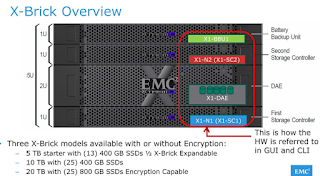.
An X-Brick provides four 10 GbE iSCSI and four 8 Gb Fibre Channel front-end ports. Each X-Brick
in a multi X-Brick cluster requires a BBU. An X-Brick configured as a single X-Brick cluster requires an extra BBU. We will talk more about clusters in an upcoming slide. Each X-Brick is configured as an Active/Active highly-available clustered storage array, without any single pointof-
failures.
system. It can be deployed on a dedicated physical server, or as a virtual machine on VMware
using an OVA template. It is not supported on Hyper-V. The XMS is preinstalled with the CLI and
GUI via a Java WebStart application. The XMS must access all management ports on the X-Brick
storage controllers, and must be accessible by any GUI/CLI client host machine. Since all
communications use standard TCP/IP connections, the XMS can be located anywhere that satisfies
these requirements.
Only one XMS is required per cluster. If you have two single X-Brick clusters, then you must have
two XMS deployments, one for each.
XMS provides access to:
• Cluster health, events, and cluster performance
• Performance statistics history database
• Volume management
• Data protection groups operation logic
• Stopping, starting, and restarting of the cluster
The CLI allows cluster administrators and operators to perform supported management
operations. It is pre-installed on the XMS, and can also be accessed using standard SSH
programs.
to note that I/O’s and storage capacity provided by the X-Brick cluster scale simply by increasing
the number of X-Bricks in the offering with no impact on latency. When the cluster expands,
resources remain balanced, and data in the array is distributed across all X-Bricks to maintain
consistent performance and equivalent flash wear levels.
Storage capacity and performance scale linearly, such that two X-Bricks supply twice the IOPS
and four X-Bricks supply four times the IOPS of the single X-Brick configuration. However, the
latency remains consistently low (less than 1 ms) as the cluster scales out.
*The IOPS displayed on the slide come from a purely random 8 KB 70% read 30% write I/O
workload. For a purely random 8 KB write I/O, the number of IOPS is 100 K per X-Brick. For a
workload consisting of a 50/50 mix of random 8 KB write/read I/Os, the number of IOPS is 150 K
per X-Brick.
All X-Bricks in a cluster must be of the same type (either 400 GB, 400 GB Encryption Capable, or
800 GB Encryption Capable). The 400 GB Expandable Starter X-Brick is encryption capable and is
available as a single X-Brick configuration only.





No comments:
Post a Comment